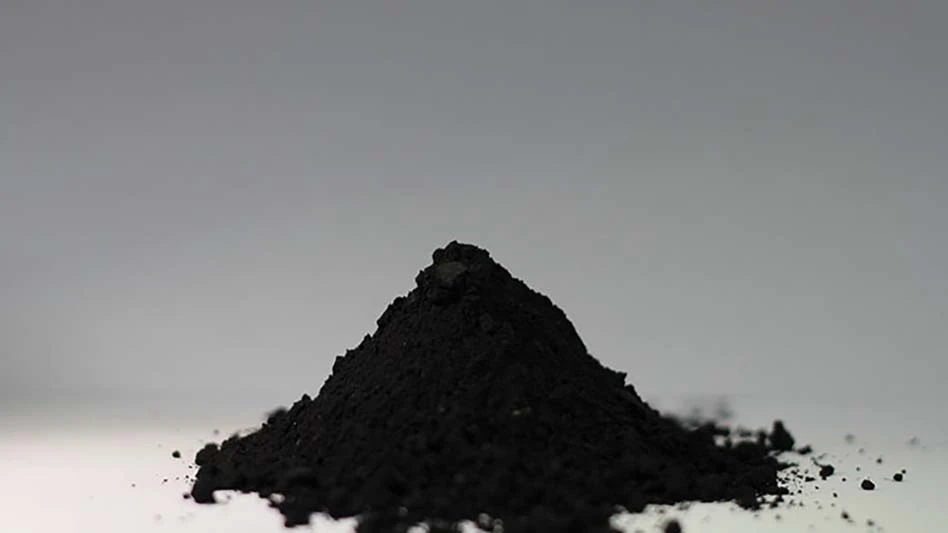
Photo courtesy of Li-Cycle
Platts, part of S&P Global Commodity Insights, has launched four U.S. spot physical black mass price assessments. Valued on a delivered-duty-paid (DDP) basis, the assessments build on black mass price references launched in April for Europe and Asia, according to the company, and complement Platts’ existing suite of daily battery metals price assessments.
Black mass is a recycled material produced by collecting, dismantling and shredding production offcuts or used rechargeable batteries. Critical materials such as lithium, nickel, cobalt and manganese can be extracted from the black mass and reintroduced to manufacturing.
Platts says it is focusing its US Black Mass assessments and calculations on nickel-cobalt (Ni-Co) containing material, which includes battery production scrap and spent lithium-ion batteries. The assessments reflect the percentage value, or payable, of black mass constituents, based on the minimum quality specifications of each key component: lithium, cobalt and nickel.
Platts has also launched a new calculated theoretical nickel-cobalt, or Ni-Co, black mass price DDP U.S. in dollars per metric ton. The calculation combines Platts daily spot market assessments of Ni-Co key component payables with the underlying Platts or London Metal Exchange pricing basis for lithium, cobalt and nickel, respectively. The assessments are as follows:
- Platts Ni-Co Black Mass DDP US Lithium payables (minimum lithium 3 percent);
- Platts Ni-Co Black Mass DDP US Cobalt payables (minimum Co 5 percent);
- Platts Ni-Co Black Mass DDP US Nickel payables (minimum Ni 10 percent); and
- Platts Ni-Co Black Mass DDP US calculated price (minimum lithium 3 percent, Co 5 percent, Ni 10 percent) dollars per metric ton.
Platts black mass assessments reflect market information reported to Platts and published throughout the day, including firm bids and offers, transactions and indications, as well as any other data deemed relevant to the assessment process.
The full description of the Platts assessments methodology and data prioritization can be found here.
The company’s methodology for its U.S. black mass price assessments is similar to the methodology used for the European and Asian assessments, though the minimum amount of metals is higher in those assessments at 4 percent for lithium, 10 percent for cobalt and 20 percent for nickel, which Christopher Davis, regional director, Metals Pricing – Americas, S&P Global Commodity Insights, says reflects the market dynamics at play and the feedback Platts received from the various market participants.
“Not only are these new Platts U.S. Black Mass price assessments the first domestic price offerings of their kind, they’ll be published daily,” he says. “The most important thing to note, though, is they will bring greater transparency and help quantify value for this emerging, opaque and nonstandardized battery raw materials market."
In response to Platts’ black mass price references for Europe and Asia, Davis says, “The market has been very appreciative of our efforts to bring transparency to what has been an opaque marketplace for the most part.”
He adds that Platts continually evaluates opportunities and feedback it receives from the market and wanted to further build out its offering of price assessments with the release of the U.S. spot physical black mass price assessments.
Platts selected the daily cadence for its assessments, Davis says, because it felt like that would best represent the changes that occur in the spot market. “We wanted to capture the changes as they happened in real time.”
Platts says it has observed growing interest in black mass recycling, which is expected to play an integral role in future battery metals supply. The processing of black mass has grown in importance as a supplement to virgin mined material and as a means of reducing the carbon footprint of the battery supply chain.
Anna Crowley, global head of Metals Pricing, S&P Global Commodity Insights, adds, “We’re pleased to be following on our Black Mass offerings launched earlier this year in Asia and Europe with a Western price offering for the U.S., further filling out the global battery raw materials supply chain. All our assessments and data are aimed at meeting market participants' growing needs for full-life-cycle battery metals information and additional supply chain insights, as well as facilitating energy transition.”
With sustainability and energy transition a growing focus globally, S&P Global Commodity Insights says it expects recycled battery materials to make up a rapidly increasing share of the battery material supply chain well beyond 2030. The potential availability of recycled materials could account for 30 percent of nickel, 27 percent of lithium and 40 percent of cobalt demand between 2020 and 2050. Importantly, battery recycling has the potential to be less expensive than its virgin-material equivalents and create supply in regions that do not have natural resources available while also being less carbon-intensive.
The Platts US Black Mass price assessments are available through S&P Global Commodity Insights products and services and are published on the Platts Nonferrous Metals Alert pages, Platts Metals Daily, Platts Metals Week, Platts Dimensions Pro, Platts Market Center and in the Platts price database, alongside Platts’ full suite of battery metals assessments.
Latest from Recycling Today
- BMW Group, Encory launch 'direct recycling’ of batteries
- Loom Carbon, RTI International partner to scale textile recycling technology
- Goodwill Industries of West Michigan, American Glass Mosaics partner to divert glass from landfill
- CARI forms federal advocacy partnership
- Monthly packaging papers shipments down in November
- STEEL Act aims to enhance trade enforcement to prevent dumping of steel in the US
- San Francisco schools introduce compostable lunch trays
- Aduro graduates from Shell GameChanger program





